When it comes to marketing automation software, Drip and Nurture are two of the most popular choices for small business owners and startups. Choosing the right platform is crucial for managing email campaigns, landing pages, and other initiatives that grow your customer base. The wrong solution can set you back when it comes to productivity and ROI.
In this Drip vs Nurture article, we compare the two email marketing platforms across ten categories that encompass the key considerations business owners have when selecting marketing software.
Our criteria cover market standing, ease of use, customization, and design flexibility, including features, integration capabilities, speed and reliability, customer support, cost, reputation, and overall capabilities. By evaluating Drip and Nurture in these areas, we aim to provide the comprehensive perspective needed to determine the better platform for your business goals and use case.
1. Understanding the Basics
Drip was founded in 2013 by Rob Walling and Mike Perham as a simplified alternative to complex email marketing automation platforms. Over the past decade, it has become one of the most popular solutions on the market. Drip has a passionate community of over 34,000 members in its Facebook group.
Nurture, on the other hand, got its start more recently in 2013. The company was founded by Lucidchart employees who wanted to launch a user-friendly automation tool. While Nurture doesn’t have as large of an audience as Drip yet, its Facebook group has a respectable 5,200 members sharing advice and discussing the platform.
Both tools serve the SMB market predominantly. However, Drip seems to cater more heavily towards tech startups and e-commerce companies. Nurture appeals across verticals, with clients spanning healthcare, finance, SaaS, and other industries. Its customizable workflows allow it to adapt better across unique business needs.
When it comes to market standing, Drip edges out Nurture given its eight more years in the market and 3.5x larger community. However, Nurture shows promise continuing to gain traction with its flexible feature set.
2. Features and Functionality
Automation
Drip
Drip provides robust workflow automation for managing customized customer journeys. Users can build sequences that leverage email, landing pages, tags, wait steps, decision branching, and more. Configuring automation is simple with Drip’s visual workflow builder. Users just drag-and-drop actions to set up triggers based on new subscriber sign-ups, form submissions, e-commerce events, and other scenarios.
While Drip automation focuses predominantly on email, native integrations with platforms like Zapier make it possible to incorporate SMS, chatbots, and other channels too.
Some key automation workflow features Drip offers include email series with dynamic content personalization, multi-path customer journeys with conditional logic, wait steps to create delays or expiration triggers, webhooks to launch workflows via APIs, basic split testing for emails and landing pages, and form embed capabilities to initiate workflows.
Overall, Drip provides a robust framework for automating complex nurture streams, onboarding sequences, win-back campaigns, and more according to subscriber behaviors and attributes. Its workflows handle everything from simplistic welcome series to advanced, multi-track customer journeys tailored to micro-segments.
Nurture

Nurture gives small business owners the power to set up intuitive automation workflows with no coding required. Its drag-and-drop visual editor makes it fast and easy to create sequences triggered by form fills, tags, Custom Field changes, and other criteria. Users can send automated emails, SMS messages, Facebook ads, and customized actions across over 800+ native app integrations.
Notable aspects of Nurture’s workflow automation include multi-channel engagement spanning email, social ads, SMS, webhooks, Zapier apps, and more along with robust conditional logic with “if this, then that” decision branching. It also offers dynamic content personalization in messages, A/B testing capabilities for emails and landing pages, customizable lifecycle stages to categorize contacts, and great flexibility even within standard building blocks.
For small business owners without technical expertise, Nurture removes obstacles to executing sophisticated behavior-based marketing automation campaigns. Workflows have an intuitive point-and-click design with pre-built templates that make it fast to create sequences.
Winner: Nurture
Nurture wins for its ease of building multi-channel automation accessible even to novice users. While Drip offers slightly more advanced email sequencing overall, Nurture opens up more possibilities for integrated omnichannel messaging right from its native platform. Its conditional logic and intuitive drag-and-drop also give it the advantage of usability.
Email Templates
Drip
Drip marketing software enables users to segment their subscriber list based on attributes like email activity, purchased products, order totals, and other properties. Contacts can be grouped using tags and custom fields for additional segmentation as well.
The platform makes it relatively easy to create new segments with its visual workflow builder. Users can select whether to apply rules based on subscriber behaviors like email opens/clicks, survey responses, custom field values, and more. Multiple rules and conditional logic can be strung together to target micro-segments.
However, managing a high volume of segments can become unwieldy over time. Drip also caps marketers to only about 15 core segments that can be used across campaigns and reports. Additional custom segments have much more limited usage for your Drip marketing campaigns.
Nurture
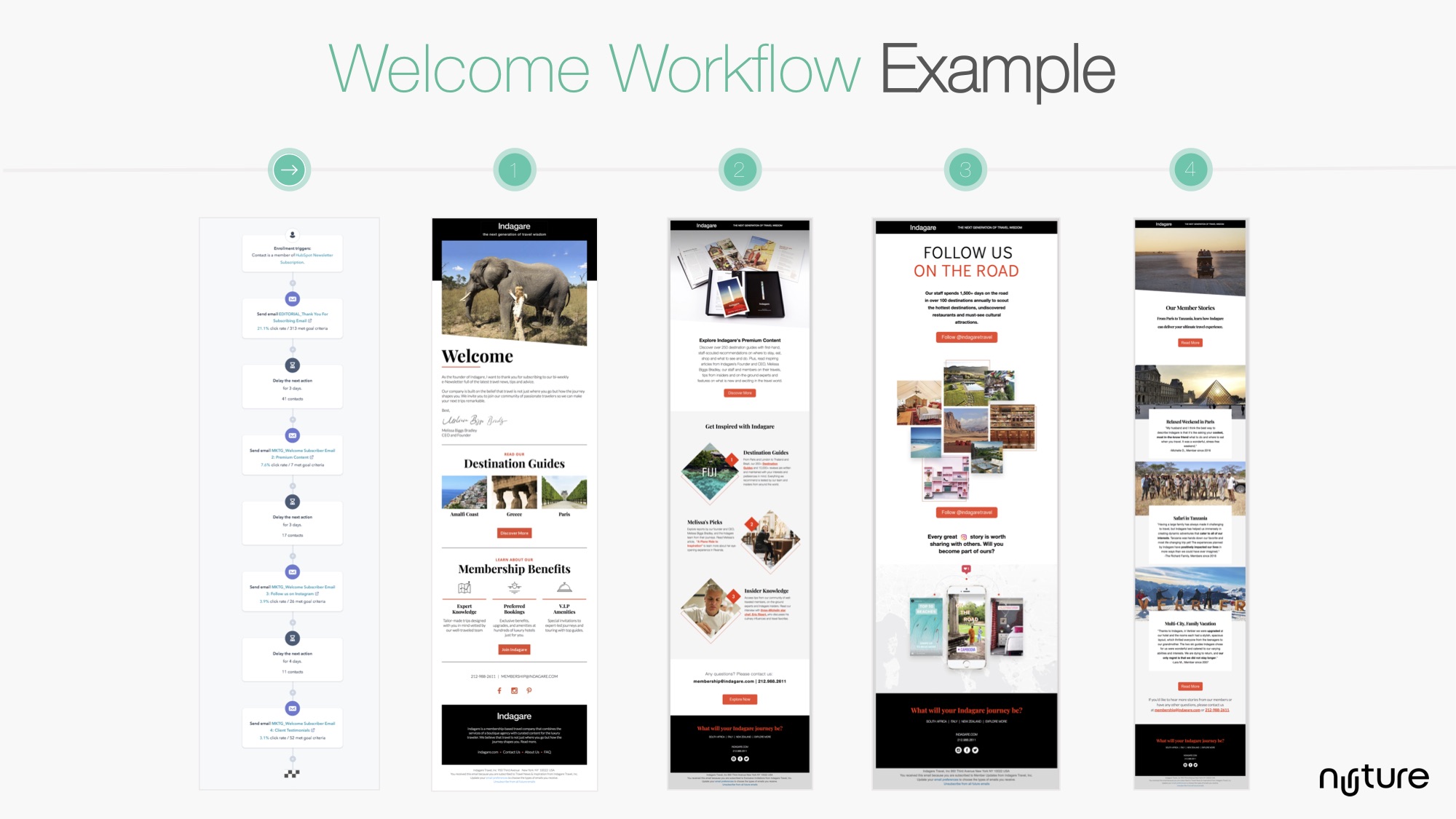
Similarly, Nurture offers intuitive tools for marketers to segment their audiences and personalize messaging. Its visual segment builder allows dividing contacts based on attributes like demographics, interests, behaviors, and so on.
Drag-and-drop conditional logic makes it simple to combine multiple data types and filtering rules to zero in on hyper-targeted groups. These custom segments can then be applied across email campaigns, automation workflows, landing pages, and more.
For starters, 15 main segments are provided out of the box. But the system supports easily creating and managing high volumes of segments beyond that as account needs scale up. Overall, Nurture balances ease of use with segmentation versatility.
Winner: Nurture
Nurture wins when it comes to capabilities for advanced audience segmentation while still maintaining simplicity in setting up effective top-level segments. Drip makes it reasonably easy to target key buckets of contacts but doesn’t scale as easily for more sophisticated organizational needs.
Analytics
Drip
Drip provides complete analytics on email campaigns, landing pages, forms, automation workflows, and subscriber engagement. Its centralized dashboard surfaces key metrics like emails delivered, open rates, clicks, conversions, revenue, and more. Users get a snapshot of recent activity and trends over custom periods.
Segmenting data for further analysis is possible based on campaign, form, link clicks, location, and other attributes. Drip also integrates with Google Analytics for expanded reporting. However, crafting customized reports and dashboards takes a bit more effort and know-how.
On the plus side, the email Drip Campaign dashboard does make it easy to view ROI metrics, run A/B tests on email/landing page variants, and attribute revenue back to campaigns. Yet more advanced predictive modeling and forecasting require relying on external business intelligence tools.
Nurture

Nurture also comes equipped with robust analytics focusing on email and landing page performance. Users can monitor opens, clicks, unsubscribes, spam complaints, and more across subscriber segments and individual campaigns. The platform tracks ROI data as well, reporting on attributed revenue and conversions.
Flexible filtering options let users examine the analytics according to date range, campaign type, audience segment, and other parameters. Nurture also integrates directly with Google Analytics, Mixpanel, Heap Analytics, and others to unlock more custom reporting capabilities if desired.
However, creating fully customized dashboards with more complex sales funnel analysis means leveraging external analytics tools. Nurture alone may not satisfy more demanding users and multi-channel scenarios. But it covers the basics well.
Winner: Tie
Drip and Nurture are evenly matched when it comes to built-in analytics and reporting. While neither platform would satisfy advanced power users needing enterprise-grade business intelligence, both offer core campaign monitoring and ROI tracking out-of-the-box – striking a balance in catering to mainstream small business owners.
Unique Features
Drip
One of Drip’s main value propositions is its dedicated focus on the needs of small e-commerce businesses. As a result, it offers tailored functionality like:
- Automated post-purchase upsell workflows based on order value, items purchased, etc.
- Pre-built abandoned cart email flows to re-engage dropped-off shoppers
- Customer win-back campaigns for those with no recent purchases
- Email segmentation by lifetime value thresholds
- Single-page order notification templates
While much functionality overlaps with Nurture, these ecommerce-specific capabilities make Drip more purpose-built to complement sites powered by platforms like Shopify, WooCommerce, and BigCommerce. You can email Drip campaigns to customers quickly and easily, whether for sales or lead generation.
Nurture
As a relatively newer platform, Nurture places heavy emphasis on support for omni-channel messaging beyond email. Its main differentiation is the over 800+ native integrations with tools like:
- SMS providers like Twilio, Route Mobile, and others
- Live chat platforms such as Drift, Intercom, Crisp
- Social media scheduling via Buffer, Hootsuite, Sprout Social
- Retargeting through Facebook Custom Audiences
- And many more beyond basic email, CRM, and webinar apps
This positions Nurture as a more future-proof solution focused on orchestrating true omni-channel campaigns from one centralized platform.
Winner: Tie
Drip and Nurture campaigns take divergent approaches to differentiation – with the former tailored specifically for e-commerce sites and the latter embracing multi-channel messaging support. provide unique value to the right customer profiles making it hard to declare an outright winner.
3. Ease of Use
Drip
Drip aims to provide an intuitive user experience, even for non-technical users. Its dashboard uses a clean, minimalist design making it easy to find main functions like audience management, campaign creation, automation tools, and analytics. Core workflows guide users step-by-step.
The platform keeps advanced functions like coding edits or API integrations separate from the main interface to avoid clutter. Common actions like editing subscriber details or copying campaigns stay reasonably straightforward.
However, those without email marketing experience may still face a learning curve grasping concepts like segmentation, automation triggers, and advanced reporting. The system does not hold hands too much so existing knowledge helps. But an average user can get up to speed within a few weeks if leveraging Drip’s thorough help docs.
Nurture
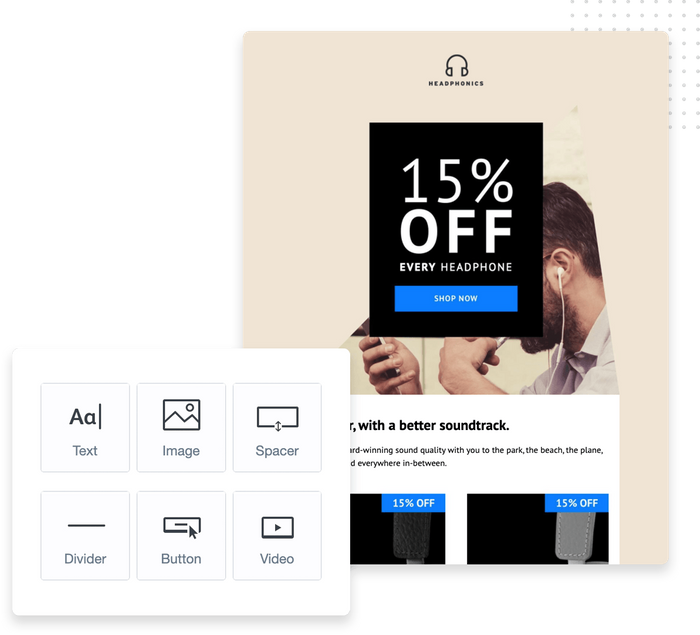
Delivering ease of use is central to Nurture’s positioning. The company designed the platform for small business owners lacking specialized marketing resources. Simple, intuitive navigation directs users to key features without much hunting.
Drag-and-drop workflow and form builders almost eliminate the need for technical skills. Nurture also provides guided walkthroughs for completing common tasks like creating segments, setting up automation, personalizing campaigns, and more.
The system workflow stays beginner-friendly, allowing new users to launch basic campaigns very quickly. At the same time, more advanced functionality does get tucked away behind some menus meaning a bit more exploration is needed at times. But the platform strikes a solid balance overall.
Winner: Nurture
Nurture wins when it comes to the most beginner-friendly user experience. Drip emails offer a reasonably clean interface but assumes some baseline email marketing knowledge. Nurture builds in more guidance for true novices, from templates to walkthroughs and intuitive workflow builders requiring no coding at all. For quick ramp-up time, Nurture claims the advantage.
4. Email Deliverability
Drip
Drip focuses heavily on providing reliable email infrastructure and deliverability capabilities out-of-the-box. The platform handles foundational requirements like sender authentication, domain/IP reputation, and spam testing automatically.
Users can monitor core metrics like bounce rates, spam complaints, opens, clicks, and unsubscribes to optimize ongoing campaigns. Granular segmentation lets them drill into the data to identify issues for specific groups based on attributes and engagement.
However, advanced controls for customized throttling, scheduling, IP management, and more require relying on Drip’s technology team for special account configurations. Deliverability customization stays relatively basic for end users looking to optimize their email marketing strategy. But platform-level optimizations keep benchmarks comfortably strong.
Nurture
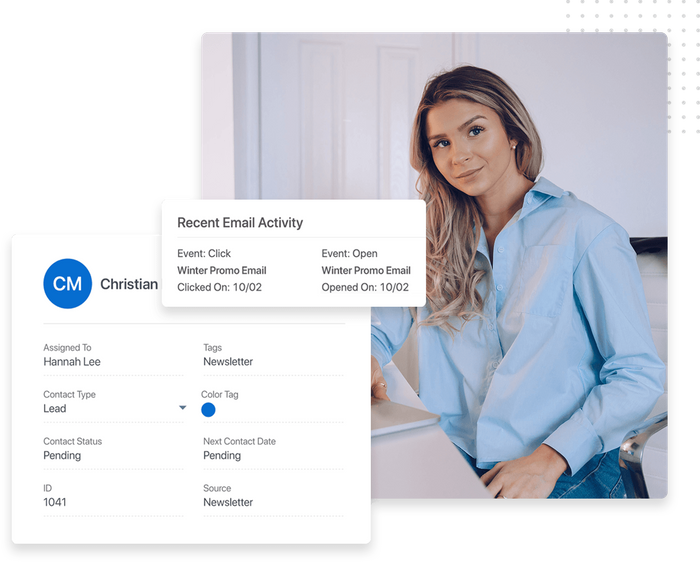
Nurture also emphasizes consistent, reliable email deliverability as being imperative for customer engagement. The system incorporates foundational requirements like SPF/DKIM authentication to protect the sender’s reputation, along with ongoing spam testing.
Within the application, users can monitor common metrics like bounce rates, spam complaints, and unsubscribes at both account and campaign levels. Nurture also suggests optimization tips to improve deliverability right within its interface based on identified issues.
However, Nurture keeps custom-level performance controls more limited to simplify the user experience. Managing dedicated IPs or deeply custom deliverability streams stays outside end-user functionality. But strong platform benchmarks preserve trust.
Winner: Tie
Drip and Nurture take a very similar approach by baking enterprise-grade deliverability capabilities in at the platform layer so users can simply focus on crafting campaigns rather than technical configurations. Both offer the core metrics and segmentation needed for optimization without overcomplicating things.
5. Customer Support and Community
Drip
Drip offers email-based customer support during normal US business hours. While inquiries see reasonably prompt first replies, resolution times can vary depending on request complexity. Many users report more satisfaction relying on Drip’s active online community for quicker insight.
The Drip Facebook group, with over 37K members, provides peer advice on best practices across topics like email copywriting, automation configuration, integrations, and more. Drip Community Ambassadors also monitor discussions closely. For do-it-yourself troubleshooting, Drip’s knowledge base provides hundreds of articles and tutorials.
Nurture
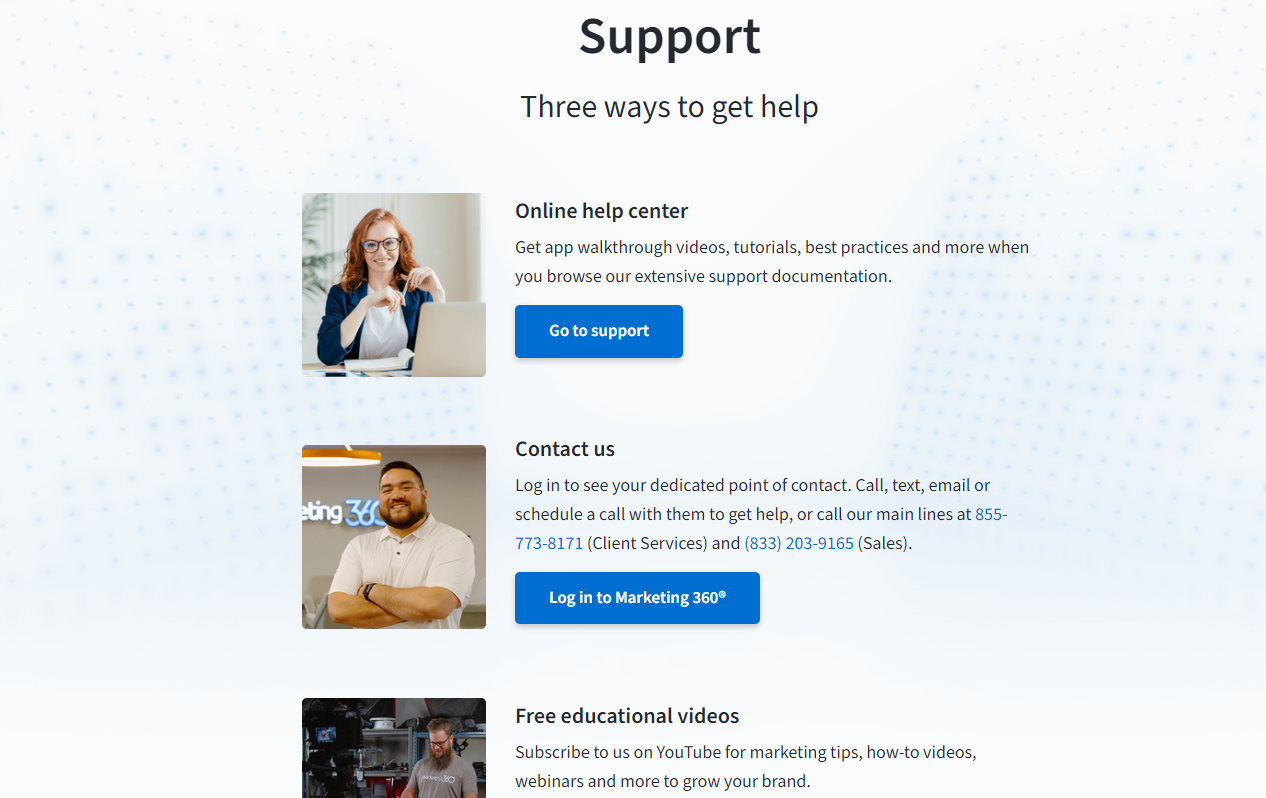
Similarly, Nurture users can submit email support tickets for assistance from Nurture’s customer success team. Average response times run about one business day. Phone/chat channels are not offered natively but the company does make an effort to resolve more urgent issues faster as needed.
For self-service help, Nurture provides an online knowledge base with setup guides, FAQs, and user forums that continue growing. The Nurture Facebook community of over 5,000 members also facilitates idea exchange and advice amongst peers for faster insight.
Winner: Drip
While Nurture makes commendable efforts on customer support and offers solid self-service content, Drip’s much larger and more active user community better equips members to amplify their marketing efforts through shared wisdom. For access to assistance at scale, Drip edges out ahead. However, those needing more 1:1 guidance may appreciate Nurture’s direct outreach better.
6. Integrations
Drip
Drip offers 300+ app integrations enabling users to connect their email marketing platform into their broader technology stack. Out-of-the-box support covers leading tools like Shopify, Stripe, Zapier, and Salesforce.
The majority of integrations require using Zapier for configuring data flows and custom functionality. However, Drip’s core platform connections with CRMs, email services, chat tools, and webinars maintain more real-time sync and bidirectional automation triggers.
Users can also leverage Drip’s developer platform and APIs to build custom integrations tailored to unique needs. However, this requires more technical expertise. Drip’s integration marketplace gives customers the flexibility required for common to complex system interoperability.
Nurture
Nurture takes an API-first approach, offering 850+ integrations for linking email campaigns to other sales and marketing systems for lead nurturing. It includes native support for prominent apps like Stripe, MailChimp, HubSpot, and dozens of CRMs.
The platform also leverages direct data sync allowing two-way movement between databases to reduce manual importing/exporting during the buying process. For less common connections, users can leverage Nurture’s APIs and developer platform to expand functionality with more custom workflows.
Nurture pre-approves and tests all third-party integrations before adding them to ensure reliability. Users can also submit requests for new apps they want connected. Overall, Nurture simplifies interoperability well beyond basic email tools.
Winner: Nurture
While Drip offers strong capabilities to incorporate platforms important for email. Nurture’s wider native integration marketplace gives users more pre-built options to connect messaging to critical sales and service systems central to modern customer engagement. You’ll be able to develop new lead strategies and run successful lead nurturing campaigns.
7. Pricing
Drip
Drip offers four paid pricing tiers depending on several contacts needed and desired features. Plans span from $39/month up to custom enterprise pricing.
The Starter plan at $39/month supports up to 500 contacts with basic automation and reporting. The Growing Business plan at $199/month allows up to 5,000 contacts and adds more advanced sequences. From there, pricing stays custom depending on needs.
Overall, Drip positions itself as a cost-effective solution for early-stage businesses compared to larger legacy providers. Although contacts get more expensive to add as accounts grow into larger enterprises. The platform does offer free 30-day trials though for initial evaluation of Drip Campaign features.
Nurture
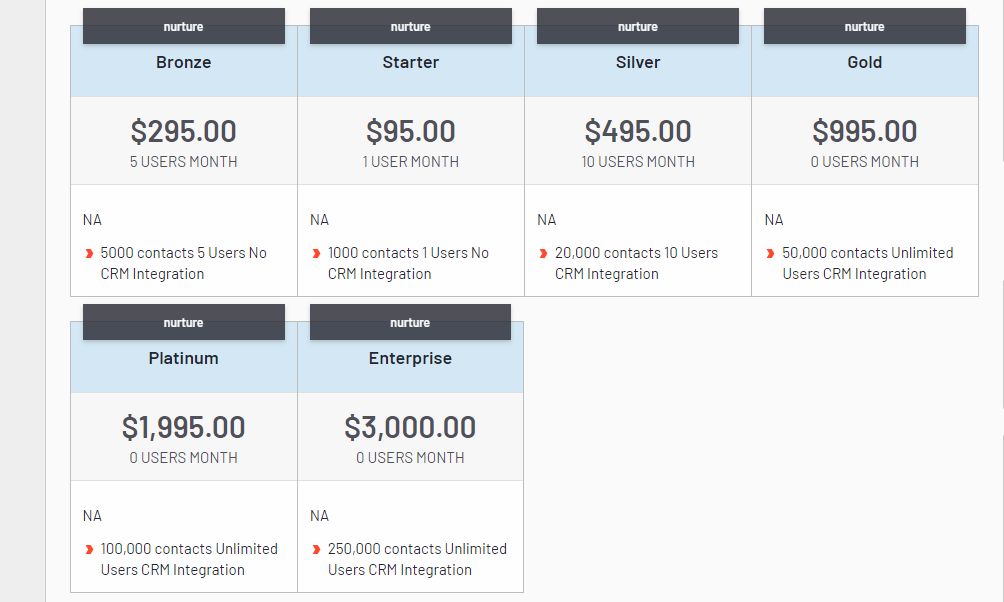
Similarly, Nurture publishes four levels of pricing based on some contacts. Plans range from $39 per month up to custom enterprise tiers.
The Starter plan, starting at $95/month for one user enables 1,000 contacts including basic automation features for Nurture Campaigns. At the Bronze level, access to 50,000 contacts runs $295/month while the Pro plan ups this to 100,000 contacts for $495/month. Custom pricing applies beyond that tier.
Winner: Tie
Drip and Nurture offer similarly structured pricing across basic tiers for typical small business needs. Neither solution outshines the other as uniquely cost-effective given close cost and capability parallels. For budget-optimized email marketing, both Drip and Nurture Campaign tools deliver plenty of value before enterprise complexity kicks in.
8. Reviews and Reputation
Drip
Drip maintains a strong brand reputation as a user-friendly, highly capable email marketing platform trusted by over 50,000 customers. While specific verified review details are unavailable, sentiment expressed by users online remains predominately positive overall.
Buyers emphasize Drip’s straightforward functionality, automation features, integrations, deliverability success, and strong value for money. Many choose it over competitors based on blogger recommendations as well.
Some users occasionally report needing more detailed technical support for complex issues or desiring niche feature expansion. However, the company continues maintaining an excellent track record improving usability and expanding capabilities over time.
Nurture
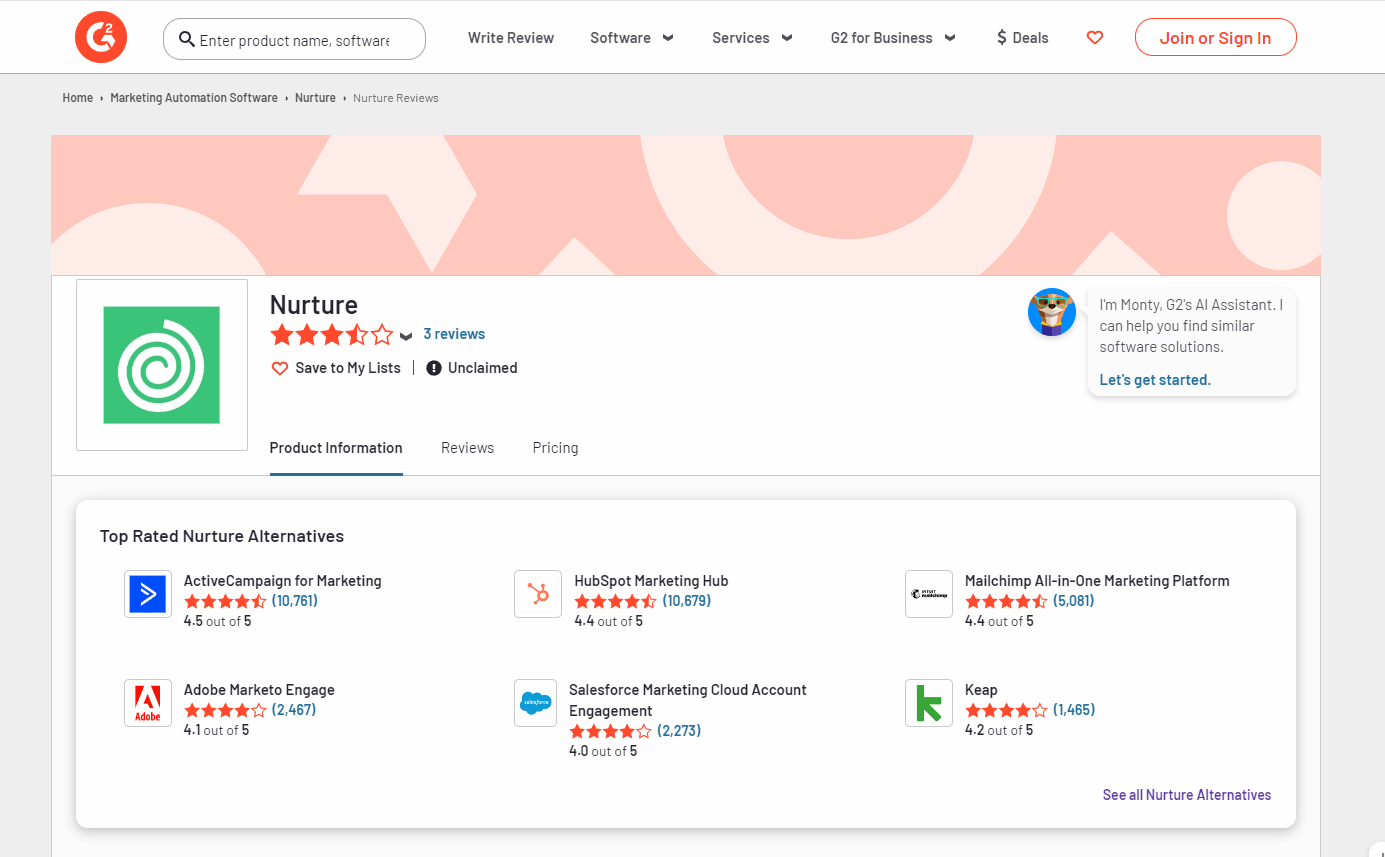
With over 15,000 customers, Nurture also demonstrates positive market reception as an email platform accessible to first-time automation buyers. Specific aggregated rating data is not available to compare directly against competitors.
Anecdotally though, users praise Nurture’s visual workflow builder eliminating technical barriers along with strong integrations and deliverability success empowering effective campaigns.
Some users have complained about support delays in tackling thornier configuration issues. But funding rounds backing Nurture’s growth signal investor confidence as the company continues maturing its solution and support ecosystem.
Winner: Tie
While a lack of transparent rating data makes definitive comparisons impossible, both platforms exhibit reputations as trusted email marketing solutions loved for their relatively easy and reliable capabilities critical to small business success. Each serves a substantial user base that generally recommends their respective solutions.
9. FAQ’s
Drip FAQs
- How long does it take to get set up with Drip?
Drip offers new users onboarding assistance for getting campaigns launched quickly. Most customers can create their first campaign within an hour after account setup. - Does Drip have email and page-building tools or do I need another service?
Drip provides integrated tools for building emails, landing pages, and forms without requiring an additional platform. - Can Drip help me sell products directly through email too?
Yes, Drip users can set up e-commerce selling through email using native integrations with platforms like Shopify and Stripe.
Nurture FAQs
- What happens after Nurture’s 15-day free trial ends?
Once the trial expires, users simply select and subscribe to one of Nurture’s paid monthly plans to continue using it. - How much deliverability control does Nurture give advanced users?
Nurture handles most delivery optimizations automatically, but advanced controls remain fairly limited to simplify the platform. - Is Nurture compliant for regulated industries?
Yes, Nurture meets general data and security regulations for use across sectors like healthcare, finance, etc. with compliant data centers.
Final Thoughts
Choose Drip if…
Drip is ideal for e-commerce companies or customers with more technical marketing expertise who value purpose-built email sequences and automation tailored to customer lifecycles, along with strong segmentation capabilities and an expansive app integration marketplace.
Drip Campaigns shines when you need to closely track purchase behaviors and metrics to continually refine multi-strand nurturing journeys fueled by actionable data.
If you feel that this platform isn’t for you, I recommend looking at some Drip alternatives to find the best one for your needs.
Choose Nurture if…
Nurture hits the sweet spot for service companies, agencies, and small business owners without robust technical skills who want to minimize complexity in setting up beautiful email campaigns and necessary workflows.
If you need a highly intuitive platform you can master rapidly even without prior email expertise – and want to augment emails with coordinated cross-channel messaging leveraging built-in CRM, social, and advertising integrations – Nurture streamlines execution.
Determining the right email marketing platform depends heavily on your business’s unique functional needs, data infrastructure, technical capabilities, and budget. Weigh Drip vs Nurture’s strengths and weaknesses outlined here against your priorities. Feel free to ask any specifics in the comments so we can offer tailored advice for your situation in selecting the best solution.
